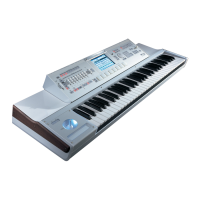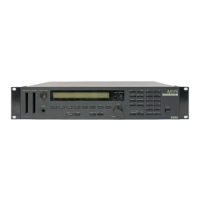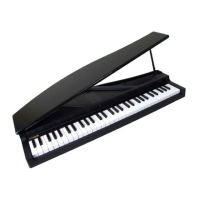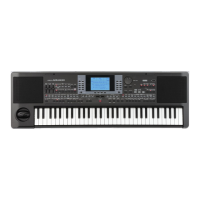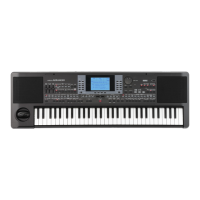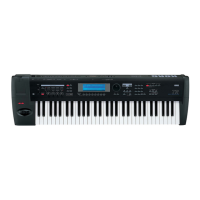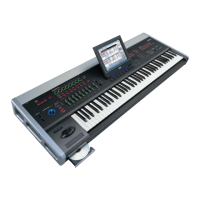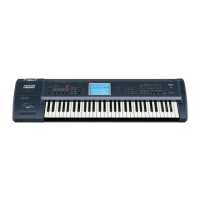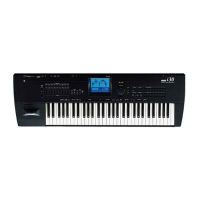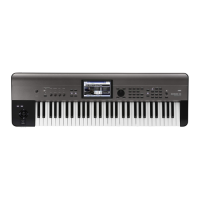Do you have a question about the Korg M1 and is the answer not in the manual?
Explains how sound is created using up to eight timbres, each assigned to a program.
Details the M1 as an eight-part multi-timbral sound module and its differences from Combination mode.
Describes playing and editing single programs, including Single, Double, and Drum modes.
Covers settings affecting the entire synthesizer, like Master Tune, Transpose, and MIDI settings.
Learn to edit values using mouse pointer, Key Focus, and De-acceleration functions.
Covers using the computer keyboard for notes, pan values, and operating controls.
Guidance on interacting with value bars, zone bars, and various types of switches.
Details graphical envelopes, filters, popup menus, and entering names.
Overview of screen elements like Mode Name, Volume, FILE/WRITE buttons, Browser, and Page Select switches.
Search, select, and manage sounds using the browser interface and its options.
Guide on using the browser to find specific sound types like multisounds and drum kits.
Details parameters for creating sounds using up to eight timbres.
Covers selecting program, output level, pan, and output destination for each timbre.
Explains parameters for the M1 as an eight-part multi-timbral sound module.
Covers selecting program, output level, pan, and output destination for each track.
Details parameters for playing and editing single programs.
Details settings that apply to the entire M1 synthesizer.
Explains how to store edited or created settings in the synthesizer's internal memory.
Guide on writing combinations, programs, and drum kits to user cards.
Details how to save internal data as files (.fxb, .fxp) on your computer.
Instructions for loading .fxb, .fxp, and MIDI controller map files from your computer.
How to import system exclusive files created on original M1 hardware.
Lists commands available in File and System menus when running in stand-alone mode.
Explains how sound is created using up to eight timbres, each assigned to a program.
Details the M1 as an eight-part multi-timbral sound module and its differences from Combination mode.
Describes playing and editing single programs, including Single, Double, and Drum modes.
Covers settings affecting the entire synthesizer, like Master Tune, Transpose, and MIDI settings.
Learn to edit values using mouse pointer, Key Focus, and De-acceleration functions.
Covers using the computer keyboard for notes, pan values, and operating controls.
Guidance on interacting with value bars, zone bars, and various types of switches.
Details graphical envelopes, filters, popup menus, and entering names.
Overview of screen elements like Mode Name, Volume, FILE/WRITE buttons, Browser, and Page Select switches.
Search, select, and manage sounds using the browser interface and its options.
Guide on using the browser to find specific sound types like multisounds and drum kits.
Details parameters for creating sounds using up to eight timbres.
Covers selecting program, output level, pan, and output destination for each timbre.
Explains parameters for the M1 as an eight-part multi-timbral sound module.
Covers selecting program, output level, pan, and output destination for each track.
Details parameters for playing and editing single programs.
Details settings that apply to the entire M1 synthesizer.
Explains how to store edited or created settings in the synthesizer's internal memory.
Guide on writing combinations, programs, and drum kits to user cards.
Details how to save internal data as files (.fxb, .fxp) on your computer.
Instructions for loading .fxb, .fxp, and MIDI controller map files from your computer.
How to import system exclusive files created on original M1 hardware.
Lists commands available in File and System menus when running in stand-alone mode.
| Polyphony | 16 voices |
|---|---|
| Keyboard | 61 keys |
| Release Year | 1988 |
| Multitimbral | 8 parts |
| Display | LCD |
| MIDI | In, Out, Thru |
| Filters | Digital filters |
| Weight | 12.5 kg |
| Type | Digital Synthesizer |
| Sequencer | 8-track |
| Memory | 100 patches, 100 combinations |
| Synthesis Type | AI Synthesis |
| Waveforms | PCM samples |
| Effects Systems | Chorus, Reverb |
| Sequencer Memory | 7, 700 notes |
| Outputs | Stereo (L/Mono, R), Headphone |
| Dimensions | 1026(W) x 329(D) x 102(H) mm |
